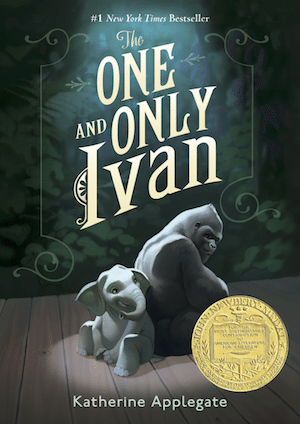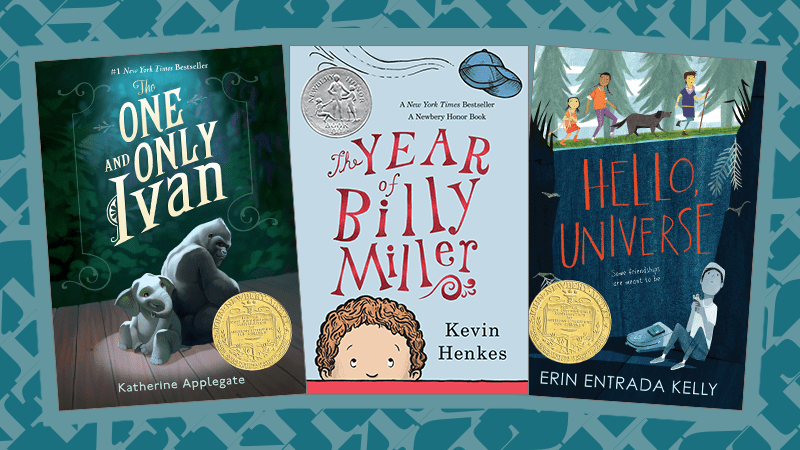One of the best ways to teach empathy to middle-grade students is by reading—because books can positively introduce relatable concepts like diversity, disability, and bullying. Use these Newbery Award–winning titles along with the corresponding teaching guides and empathy-building activities during whole-class reads or lit circles to provide a platform to teach important lessons and create a culture of kindness in your classroom.
1. Hello, Universe

Hello, Universe, a 2018 Newbery Medal winner by Erin Entrada Kelly, is a neighborhood tale that explicitly deals with topics such as embracing individuality and disabilities.
In one day, four lives weave together in unexpected ways. Virgil Salinas is shy and kindhearted and feels out of place in his crazy-about-sports family. Valencia Somerset, who is deaf, is smart, brave, and secretly lonely, and she loves everything about nature. Kaori Tanaka is a self-proclaimed psychic, whose little sister, Gen, is always following her around. And Chet Bullens wishes the weird kids would just stop being so different so that he can concentrate on basketball. They aren’t friends, at least not until Chet pulls a prank that traps Virgil and his pet guinea pig at the bottom of a well. This disaster leads Kaori, Gen, and Valencia on an epic quest to find the missing Virgil. Sometimes four can do what one cannot. Through luck, smarts, bravery, and a little help from the universe, a rescue is performed, a bully is put in his place, and friendship blooms.
Download the free teaching guide to get more discussion questions and classroom activities for Hello, Universe.
Download the Free Teaching Guide
2. The Year of Billy Miller

Kevin Henkes’ Newbery Honor book, The Year of Billy Miller, touches on topics like friendship and sibling rivalry, which makes it easy for elementary students to relate to this humorous story about the power of family love.
Billy’s mom is a teacher, and Billy’s dad works at home as an artist, spending his days finding objects he can use for his found-art sculptures. When Billy begins second grade, he is scared and unsure of how he will perform in school. To make matters worse, there is a new girl who sits at his table, and she constantly criticizes him. As the school year progresses, Billy Miller does well and overcomes his insecurities. He helps his dad with a unique found-art idea, he makes a true-to-life bat cave diorama, and he writes his mom the perfect poem. The Year of Billy Miller proves to be the best year Billy could have hoped for.
Download the free teaching guide to get more discussion questions and classroom activities for The Year of Bill Miller.
Download the Free Teaching Guide
3. The One and Only Ivan

Winner of the Newbery Medal and a #1 New York Times Best Seller, The One and Only Ivan by Katherine Applegate provides countless relatable moments for young students, which makes it a perfect story to teach empathy.
Ivan, an adult male silverback gorilla, has been living in captivity for 27 years, most of that time on display at the Exit 8 Big Top Mall and Video Arcade, along with Stella, a wise older elephant, and Bob, a sassy stray dog. Julia, the janitor’s daughter, helps Ivan with his artistic efforts. But when Mack, the owner of the mall, introduces a baby elephant named Ruby, Ivan sees his captivity for what it is. Realizing that Ruby needs more freedom, Ivan assumes his rightful place as a leader and secures a better future for himself and his friends.
Download the free teaching guide to get more discussion questions and classroom activities for The One and Only Ivan.
Teach Empathy With These ELA Activities
Try pairing the books in this article—or any books with similar themes—with these empathy-building ideas and activities:
Spark regular class discussions about emotional themes.
Take these books to the next level by holding regular class discussions centered on the emotional themes students are reading about. Dianne Edwards, a 33-year teaching veteran, recommends asking students questions and having them give personal examples. Students often label characters with a single word (e.g., lazy or kind), but when you ask them questions to help uncover the complexity of the characters, they begin to empathize. Ask questions like: What is the character feeling? How do their actions and words show this? Have you ever been in a similar situation as this character? How did that make you feel?
Write letters to characters.
Ask students to pretend they are friends with the characters in the book and write letters to them. This gives students an opportunity to empathize by sharing their advice, support, and point of view about what the character has done or said in the book. Students can also share their own similar personal experiences in the letter.
Play a freeze-frame game.
Special education teacher Amanda Greenleaf, from Marina Vista Elementary Arts Academy, uses a drama strategy she calls snapshot to help her students empathize with the characters in the books they’re reading. She asks her students to show her how they think characters feel in different situations throughout the book. Then students freeze in a pose where they express an emotion.
Use sticky notes to flag emotional parts in the book.
Have students use sticky notes to point out sections of the book that have strong emotion. They can write notes about how those parts make them feel or about a time when they experienced a similar situation. These notes can then be used to help students write journal entries or as a reference during class or group discussions.
Incorporate empathy themes into journal writing.
Ask students to write journal entries that make connections with the characters in the books. Amanda Greenleaf uses this prompt: “I think the character would feel _____ if _____ because ____.” Also, you can ask students to write about situations or emotions from the book that they’ve experienced in real life.

